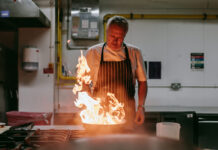Good hygiene in the kitchen has never been more important

GOOD hygiene practices are a must in commercial kitchens at the best of times, but in the midst of a pandemic where infection is spread through droplets in the air and on surfaces, it could be more important now than ever.
As Scotland’s restaurants, bars and pubs gear up to reopen for business from Wednesday (July 15), kitchen equipment suppliers, consultants and pub companies have shared their advice on how to keep kitchen areas safe for staff and reduce infection risks for customers.
Maintaining social distancing between kitchen staff is likely to be one of the big challenges, said companies.
“Operators may consider segregating the prep area and cooking areas, so staff keep to one or the other, and introduce safe distance work stations, which will need to include ingredients storage and prep or cooking equipment,” said Graham Kille of Rational.
David Glover of Wexiodisk acknowledged that implementing social distancing measures in kitchens will be “a challenge”.
“However, by re-arranging the layout of a kitchen and researching which equipment models will help with social distancing, operators will be able to rise to this challenge,” Glover said.
Alternate kitchen layouts were also advocated by Malcolm Harling at Williams Refrigeration.
“Working practices in commercial kitchens will have to change to accommodate social distancing,” said Harling.
“Creating individual chefs’ stations where everything is to hand will be part of the solution.”
And operators were advised to consider reducing their menus to require fewer people in the kitchen at any one time.
Julia Wilson of hygiene consultancy Food Alert said: “For employees, reducing the numbers of other team members they are in contact with by creating fixed teams that work the same shifts is beneficial.
“But it’s not just about the front of house teams, kitchens are often cramped, busy and noisy places so looking at ways of working, such as back to back and side to side, and keeping activity times as short as possible, for example, by reducing the complexity of your menu is advisable.”
Cleaning is always an important issue for premises preparing and serving food and this is likely to become even more pressing as venues look to ensure they are as clean and hygienic as possible.
“Maintaining hygiene standards is a priority in every commercial kitchen and the coronavirus epidemic has resulted in operators reassessing their cleaning procedures,” said Steve Morris at Jestic Foodservice.
Cutting corners is not an option.
“There simply is no short cut,” said Gary Roberts of pub company Amber Taverns.
“Never has it been more important that the correct protocols are adopted and the correct viricidal cleaning materials are used.
“Regular cleaning of all touch points will be essential to stop the spread of COVID-19.”
This was reinforced by from Kevin Robertson of Heineken-owned pub company Star Pubs & Bars, who described the cleaning of venues as “one of the key control measures for combating COVID-19”.
“A thorough cleaning regime should take centre stage in fighting the virus at every pub alongside hand washing and distancing,” said Robertson.
He directed operators to Heineken’s Pub Collective website, which includes a variety of risk assessments for licensed premises, but the “general rule is to use appropriate chemicals and clean all touch points every 30 minutes”, said Robertson.
- It’s not just surfaces that will need to be thoroughly cleaned, of course.
- And washing plates, glasses and cutlery by hand should be “avoided at all costs”, according to Paul Crowley at Winterhalter UK.
- He advised operators to make sure their kitchen staff wash their hands or change their gloves before handling clean crockery, cutlery or glassware and – ideally – these items should be stored in an enclosed space such as a cabinet or cupboard.
- “At the end of the shift, to ensure hygiene, it’s essential to clean the machine,” said Crowley.
- “Most quality designs will have a self-cleaning program. As well as reducing staff workload, this will ensure that, at the end of service, the machine is left in a safe, properly hygienic state, ready for the next shift.”



















